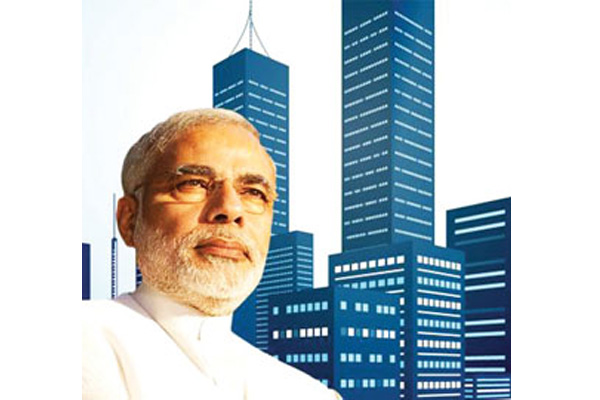
The central government may have raised the number of future smart cities from a 100 to 109, but it seems more like the numbers game than getting any closer to realisation of the ambitious project, which is close to Prime Minister Narendra Modi’s heart. Nirmal Anshu Ranjan of Elets News Network (ENN) goes beyond the obvious to spot the impediments on the way to creation of high-tech cities
Not that people weren’t familiar with the term “Smart Cities” before the BJP pushed it as a pre-poll rhetoric ahead of the 2014 General Elections; but it certainly goes to the credit of the incumbent government, which has tenaciously driven the clichéd concept to the current stage.
From announcement to create 100 smart cities to laying out a framework to give concrete shape to the Prime Minister’s pet project, the consistency and sincerity of the government’s efforts have reflected quite well.

However, while the idea of living in a smart city may have fascinated millions of citizens in India in last two years, given the complexities involved in raising smart cities, for now it looks like a tough nut to crack. Since the idea of new-age high-tech cities cannot be bound by a five-year time-frame of a government, it can understandably take some time before reaching fruition.
During the launch of Smart Cities Mission in June last year, Prime Minister Modi set a target of creating 100 Smart Cities by 2022 with an initial government investment of Rs 50,000 crore. But the reality is that the smart cities concept is still in early stages of evolution, mostly because over 60 per cent of the country’s 2025 vision of buildings and infrastructure are yet to take off on ground.

 Revery versus
Revery versus
Reality After getting selected in the category of smart cities and fast track cities, most of the cities sketched their development plans to smarten existing infrastructure through incremental improvements. But the ambitious scale of the Mission, both operationally and financially, have dawned on many cities as the concept became gradually clearer.
Today, most of the Indian cities are beset with issues such as poor quality of air, water scarcity or flooding, traffic snarls and challenges related to municipal solid waste disposal, amongst many others. That being the reason, smart cities, which are all about over – laying the city’s infrastructure, water supply, sewage, waste collection, urban mobility and other services with ICT solutions, remain a far cry, at least at present.
For the ambitious project to take off within a predictable time-frame, there has to be infra- structure, to start with. For urbanisation, the key areas of focus from a sustainability and livability perspective are energy, water, air, waste and urban transportation.
 The Fund Crunch
The Fund Crunch
As the Smart City juggernaut moves towards its destination, one of the major stumbling blocks standing in the way remains shortage of adequate fund to meet the huge costs involved in developing high-tech cities. While some resource-rich states are capable enough to tide over the fund crisis, most of the states with cities selected following the Smart Cities Challenge look up to the central government to increase the latter’s share of funding.
Recently, the Government of Himachal Pradesh urged the Centre to provide 90 per cent grant for the Dharamsala Smart City project. In other words, the State Government wants 90:10 cost-sharing pattern for the project, wherein the Union Government would contribute 90 percent grant for the project.
At present, the Union Government has pro- posed grant for the Smart City scheme under the 50:50 pattern in which the states would contribute 50 per cent grant for the project, while the Union Government is supposed to pay the rest.
Barely a week after the Himachal Pradesh Government seeking 90 per cent central funding, Tripura also raised a demand that the Centre go for 90:10 funding arrangement for all smart city projects in the north – eastern states.
Chief Minister of Tripura Manik Sarkar met Union Urban Development Minister M. Venkaiah Naidu to discuss the subject on the lines of Tripura being a feeble economy and accordingly asked for greater financial support.
So, the latest twist in the tale is how to meet the cost of building smart cities. Although public private partnerships (PPP) have been stressed upon to overcome the fund shortage, every state may not appear lucrative enough to private investors to pitch in with their stocks.
Local Institutions Undermined?
Another major concern being voiced by vari- ous quarters is an apparent threat to the local self-governing bodies of a city and the structure of administrative system defined in the Constitution by the Smart Cities Mission’s initiatives.
Members of two Pune-based citizen groups, who released a book on Smart Cities Mission recently, feel, “The Mission initiatives, like Special Purpose Vehicle (SPV), will give powers in private hands. The 72nd and 73rd amendments to the Constitution have given wider powers to the local self-governing bodies. The formation SPV for smart cities will encroach upon the rights of the local self-government.”
The book, jointly released by the Mahatma Gandhi Vichar Manch and the People’s Union, deals with the legal and constitutional aspects of the Mission as well as its larger impact on democracy.
So, all in all, it looks like before a smart city is developed and handed over to the rightful people, the proposition has to meet its share of hurdles.
What is needed at the moment is an urgency to address the issue of funding, preparing a more practicable roadmap for developing such cities and generating awareness about the pluses and minuses of having a smart city.
Be a part of Elets Collaborative Initiatives. Join Us for Upcoming Events and explore business opportunities. Like us on Facebook , connect with us on LinkedIn and follow us on Twitter, Instagram.











